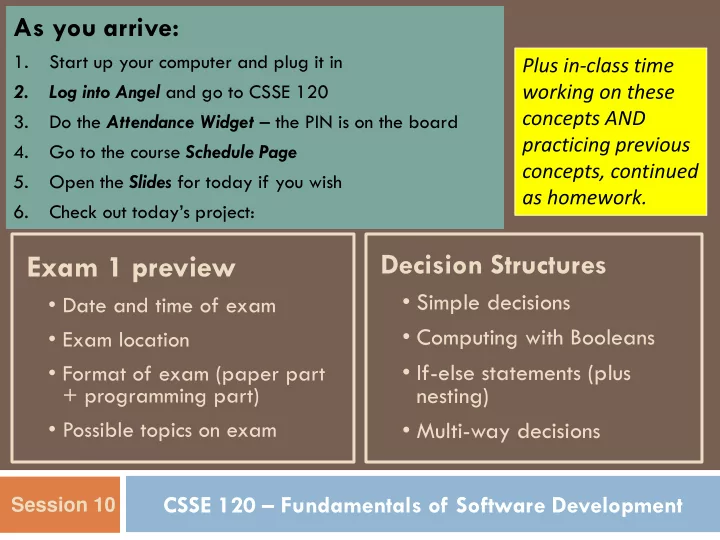

As you arrive: 1. Start up your computer and plug it in Plus in-class time 2. Log into Angel and go to CSSE 120 working on these concepts AND 3. Do the Attendance Widget – the PIN is on the board practicing previous 4. Go to the course Schedule Page concepts, continued 5. Open the Slides for today if you wish as homework. 6. Check out today’s project: Decision Structures Exam 1 preview • Simple decisions • Date and time of exam • Computing with Booleans • Exam location • If-else statements (plus • Format of exam (paper part + programming part) nesting) • Possible topics on exam • Multi-way decisions CSSE 120 – Fundamentals of Software Development Session 10
Exam 1information When? Where?: See schedule page Please get in the habit of checking the schedule page regularly . Time management is a problem solving process also Format: Paper part: Zelle book, 1 double-sided sheet of notes, closed computer Programming part: Zelle book, any written notes, and your computer Any resources you can reach from Angel or the course web site by clicking only! Q1
Possible Topics for Exam 1 Zelle chapters 1-7, 8.4 int, float conversion algorithm strings (basic operations) Comment character codes (chr, ord) variable, assignment lists (concatenation, slices) identifier, expression list methods indexing Loop reading, writing files definite (for) formatted output counted (range function) phases of software reading Writing development using objects, graphics print, input method vs. function import, math functions
More topics for exam 1 Using zellegraphics decision structures library if, elif, else computing with Booleans Functions defining calling (invoking) parameter-passing mutable parameters optional parameters return values
Control structures Normally, statements in Control structures a program execute in Statements that alter the order, one after the flow of execution of a program other Examples include Sometimes we want to Loops alter the sequential Repeat execution of a block of flow of a program code Function call What examples have we Causes execution to jump seen of this? around in the code Other
Decision, Decisions, Decisions Decision structures are control structures that allow programs to choose between different sequences of instructions. if <condition>: Expressed as an if statement <body> True and False are If the <condition> is True , execute Boolean constants the <body>
Simple conditions <condition> <expr> <relop> <expr> Some Relational operators Relational operator Math < ≤ = ≥ > ≠ Python < <= == >= > != Q2
Checkout today’s project: 10-DecisionStructures Are you in the Pydev perspective? If not: • Window ~ Open Perspective ~ Other Troubles getting Pydev then today’s project? Messed up views? If so: If so: • Window ~ Reset Perspective No SVN repositories view (tab)? If it is not there: • Window ~ Show View ~ Other SVN ~ SVN Repositories then In your SVN repositories view (tab), expand your repository ( the top-level item) if not already expanded. • If no repository, perhaps you are in the wrong Workspace. Get help as needed. Right- click on today’s project, then select Checkout . Press OK as needed. The project shows up in the Pydev Package Explorer to the right. Expand and browse the modules under src as desired.
Class Exercise In module 01-grade.py , define a function grade(score) where score is an exam score and result is "perfect", "passing", or "failing" based on the score
Comparisons--Boolean expressions Conditions are Boolean expressions They evaluate to True or False Boolean constants Try in PyDev console: >>> 3 < 4 >>> 42 > 7**2 >>> "ni" == "Ni" >>> "A" < "B" George Boole >>> "a" < "B― Q3
Boolean Variables and Operations Boolean constants: True , False Relational operators ( < , etc.) produce Boolean values. Other Boolean operators: and , or , not Truth tables Q4
Having It Both Ways: if-else Semantics: Syntax: If <condition> is True , execute these statements if <Condition>: <statementsForTrue> else: <statementForFalse> If <condition> is False , execute these statements Q5
A Mess of Nests Can we modify the grade function to return letter grades — A, B, C, D, and F?
Multi-way Decisions Syntax: if <condition1>: reach here if <case 1 statements> condition1 is false elif <condition2>: reach here if <case 2 statements> condition1 is false AND condition2 is true elif <condition 3>: reach here if BOTH <case 3 statements> condition1 AND condition2 are false … else: <default statements>
Cleaning the Bird Cage Advantages of if-elif-else vs. nesting Number of cases is clear Each parallel case is at same level in code Less error-prone Fix grade function to use if-elif-else statement instead of nesting Q6
Individual Exercise on Using if-else Finish the quiz first. Turn it in. Then open 02-ountPassFail.py Define (in that file) a function countPassFail(scores) that takes a list of exam scores returns two values: the count of passing scores in the list (those at least 60), and the count of failing scores in the list Examples: print(countPassFail([57, 100, 34, 87, 74])) prints (3,2) print(countPassFail([59])) prints (0,1) print(countPassFail([])) prints (0,0) Commit your project to your repository. Q7
Begin working on your homework A version of star that uses conditionals Follow the homework 10 instructions in this order: circleOfCircles Star Use the appropriate PyDev modules in the 10-DecisionStructures project to solve these exercises Commit your solutions to your repository
Recommend
More recommend